Process for making models of photons, electrons, magnitism, gravity and other things
a technology of photons and electrons, applied in the field of making models, can solve the problems of not being able to isolate any of the six quarks or prove they exist, not being able to prove neutrinos exist, and not having a good explanation of the internal structure of electrons or protons, etc., to achieve a strong attractive force
- Summary
- Abstract
- Description
- Claims
- Application Information
AI Technical Summary
Problems solved by technology
Method used
Image
Examples
Embodiment Construction
The Tronnie
[0047]The Ross Model is based on the existence of a previously unknown point particle (which I discovered about six years ago and call the “tronnie”) from which everything in our Universe is made. Tronnies have no mass and no volume but they do have a charge of plus e or minus e. (A charge of minus e is the charge of an electron and a charge of plus e is the charge of a proton or the charge of the positron, which is as explained above the anti-particle of the electron.) By reason of their charges, tronnies carry the Coulomb force which expands out from each tronnie at the speed of light (3×108 m / s) repelling like tronnies and attracting unlike tronnies. Each tronnie, being exactly like itself and having no mass, repels itself with its own Coulomb force, so each tronnie is always traveling at the speed of light or faster, never less than the speed of light! Each tronnie having no mass and no volume and a charge of exactly plus or minus e, is in effect one half of nothing. ...
PUM
 Login to View More
Login to View More Abstract
Description
Claims
Application Information
 Login to View More
Login to View More - R&D
- Intellectual Property
- Life Sciences
- Materials
- Tech Scout
- Unparalleled Data Quality
- Higher Quality Content
- 60% Fewer Hallucinations
Browse by: Latest US Patents, China's latest patents, Technical Efficacy Thesaurus, Application Domain, Technology Topic, Popular Technical Reports.
© 2025 PatSnap. All rights reserved.Legal|Privacy policy|Modern Slavery Act Transparency Statement|Sitemap|About US| Contact US: help@patsnap.com



